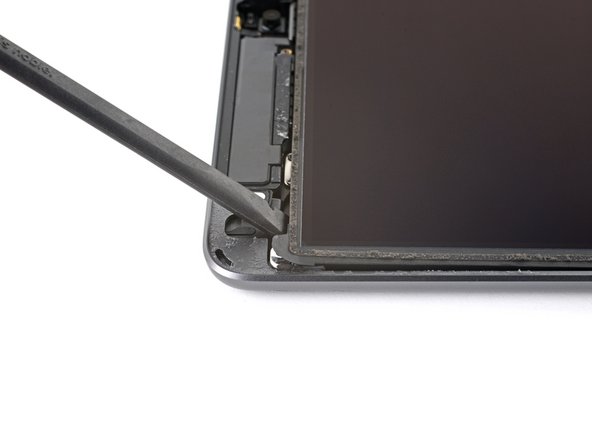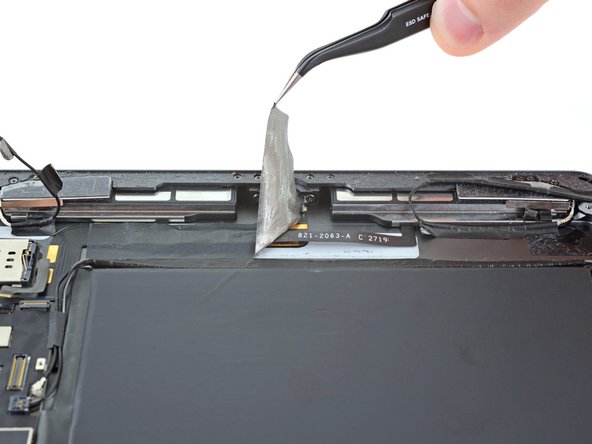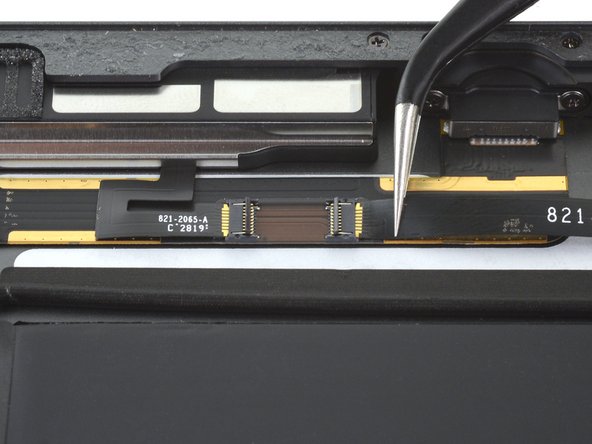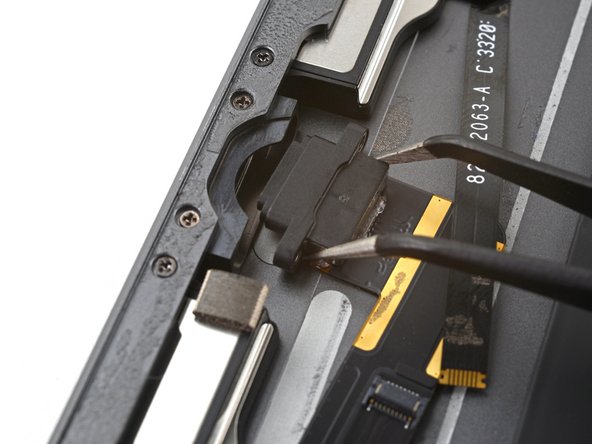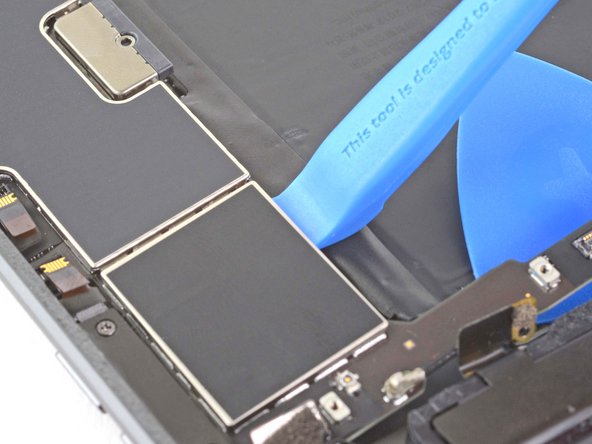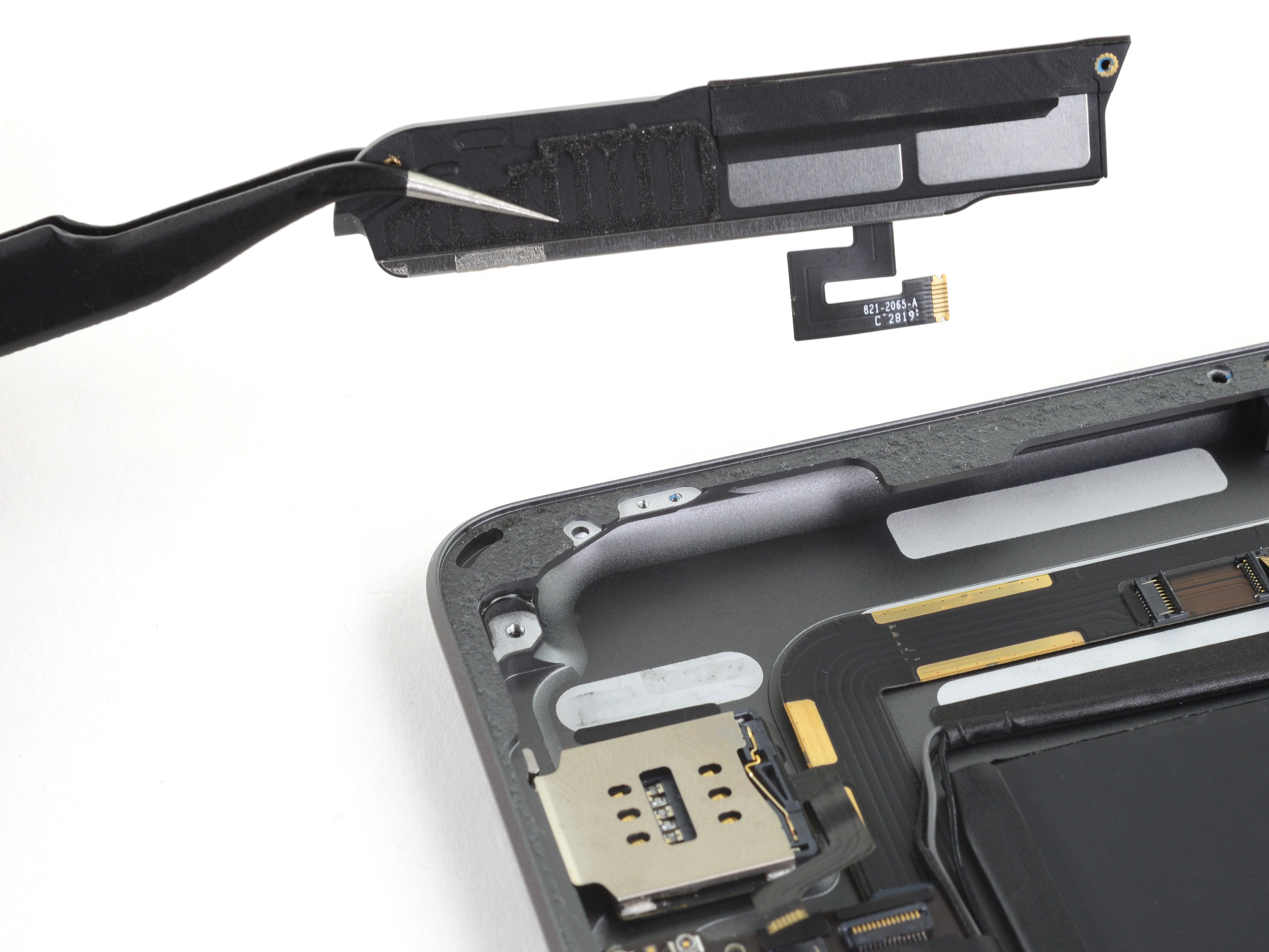iPad 9 LTE Logic Board Replacement
Duration: 45 minutes
Steps: 106 Steps
Hey there! Just a friendly reminder to drain that battery to below 25% before you dive into disassembling your iPad—safety first, folks!
Quick note about the home button: it's got a special Touch ID buddy paired with the logic board. To keep that handy feature working, don’t forget to carefully transfer and glue the original home button onto the new front panel assembly. You've got this!
Follow this guide to swap out the logic board in your iPad 9 LTE model. Heads up: this walkthrough is just for the LTE version — if you have the Wi-Fi model, check out the specific guide for that. For safety, discharge your battery to under 25% before opening up your iPad; this lowers the chance of fire if the battery gets damaged. If the battery looks swollen, take extra care. Remember, the home button’s Touch ID is linked to the logic board, so to keep Touch ID working, you’ll need to transfer and glue the original home button onto the new front panel assembly. Be super careful when disconnecting the battery with a battery blocker — those contacts are fragile and can be ruined easily. If you skip isolating the battery, avoid metal tools unless absolutely needed (like removing screws) to prevent short circuits and damage. Some pictures here might be from a different model and look a bit different, but that won’t affect the steps. If you get stuck or want a pro to handle it, you can always schedule a repair.
Step 1
- Grab a SIM eject tool, a tiny bit, or even a straightened paper clip and pop it into the SIM card tray hole.
- Gently press the tool into the hole to coax the SIM card tray out.
- Pull out the SIM card tray and set it aside.
Step 2
First things first, let's give your iPad a little nap—power it down before we dive into the repair adventure!
- Warm up an iOpener and press it against the left edge of the iPad for about two minutes. Let the heat do its magic!
Tools Used
Step 3
- While you're giving the adhesive some time to chill, keep an eye out for these delicate spots that are not fans of prying:
- Front camera
- Ambient light sensors
- Antennas
- Display cables
Step 4
In the next three steps, we'll show you how to use the Anti-Clamp, our nifty tool designed to make your opening process a breeze. If you’re not rocking the Anti-Clamp, just skip ahead three steps for another approach.
Need the lowdown on how to use the Anti-Clamp? Check out this guide.
If your iPad's surface is feeling a bit too slick for the Anti-Clamp to grip, just grab some tape to create a stickier surface.
- Slide the blue handle back to release the Anti-Clamp's arms.
- Set something under your iPad so it sits evenly between the suction cups.
- Place the suction cups near the center of the left edge—one up top and one down below.
- Keep the bottom of the Anti-Clamp steady and press down firmly on the top suction cup to get a good seal.
Step 5
- Grab the blue handle and pull it forward to lock those arms in place.
- Give the handle a full 360-degree turn clockwise, or until you see the suction cups start to stretch out.
- Keep an eye on the suction cups to make sure they stay lined up. If they start to drift apart, just loosen them a bit and realign the arms before moving on.
Step 6
Turn no more than half a twist at a time, then give it a minute to chill out. Let the Anti-Clamp and some patience do the heavy lifting for you.
Check out this guide for all the juicy details on using a hair dryer like a pro!
If the Anti-Clamp isn't doing its job and leaving a gap that's too small, just warm things up a bit more and give that handle a half turn clockwise. You've got this!
- Take a breather for a minute to let that adhesive relax and create a little opening for you.
- If your screen's not warming up enough, feel free to give it some love with a hair dryer along the left edge of the iPad.
- Slide an opening pick under the digitizer once the Anti-Clamp has worked its magic and opened up a nice gap.
- Go ahead and skip the next step; you've got this!
Step 7
Got a seriously cracked screen? Slap on some clear packing tape to give your suction cup something to grip. No suction cup? No problem—strong tape can step in as the hero here. If things are really stubborn, a dab of superglue can secure that suction cup right onto the shattered glass.
- First things first, give that screen a little warmth by holding it - it should feel cozy to the touch. Next, grab your trusty suction handle and place it on the left edge of the screen, as close to the edge as you can get it.
- Now, lift that screen gently with the suction handle to create a tiny gap between the digitizer and the frame. You got this!
- Time to slip in an opening pick right into that gap you've created between the digitizer and the frame. Easy peasy!
Tools Used
Step 8
No stress if you see the opening pick poking through the digitizer — just pull it out gently. The LCD should stay safe, but leaving adhesive behind can make things messy later on.
- Pop in a second opening pick where you just made some space.
- Slide that pick down towards the bottom-left corner of your iPad to break free from the adhesive's grip.
- Keep the pick in the bottom-left corner to stop the adhesive from getting cozy again.
Step 9
- If your opening pick gets stuck in the adhesive, don’t stress—just gently roll the pick along the edge of the iPad to keep peeling that stubborn adhesive away.
Step 10
- Gently slide your first opening pick up towards the top-left corner of the iPad to break that stubborn adhesive seal.
- Keep the pick wedged in the top-left corner so the adhesive doesn’t sneak back together.
Step 11
- Warm up that iOpener and give it a cozy hug to the top edge of your iPad for a solid two minutes.
Tools Used
Step 12
Careful! Only slide the pick in up to 7 mm to keep the ambient light sensor safe and sound.
- Twist that pick around the top-left corner of the iPad to break free the adhesive. Keep it steady and show that sticky stuff who's boss!
Step 13
Keep the pick away from the front camera—sliding over it could mess up the lens. The next steps will show you how to steer clear and keep it safe.
- Gently slide the opening pick along the top edge of your iPad, but pause right before you reach the front camera to keep things safe and sound.
Step 14
- Gently pull the pick out so just the tip stays tucked between the digitizer and the frame.
- Carefully slide the pick over the front camera to loosen that sticky adhesive.
- Keep the pick resting near the right side of the front camera before moving on to the next step.
Step 15
- Slide the pick back in and gently glide it toward the top-right corner to fully break through the stubborn adhesive.
- Keep the pick wedged in the top-right corner to stop the adhesive from snapping back together.
Step 16
- Warm up an iOpener and place it on the right edge of the iPad for a solid two minutes to loosen things up.
Tools Used
Step 17
Be sure to only slide that pick in about 4 mm to keep the ambient light sensor safe and sound!
- Gently twist the pick around the top-right corner of the iPad to loosen and lift the adhesive.
Step 18
The display cables hang out about halfway up from the bottom of the iPad. Stop your slide when you're about three inches from the bottom—it's like a little dance move, but with tools!
- Pop in a fresh opening pick and glide it along to the center of the iPad's right edge. You've got this!
Step 19
- Warm up an iOpener and stick it on the bottom edge of the iPad for a solid two minutes to loosen things up.
Tools Used
Step 20
Be careful not to spin the pick all the way around the corner, or you might accidentally mess with the antenna!
Check out the third image where you'll spot the bottom-left antenna hiding beneath the digitizer. It's like a little secret waiting to be discovered!
- Gently slide the pick down to the bottom-left corner to loosen that stubborn adhesive.
- Keep the pick snug in the corner before moving on to the next step.
Step 21
Make sure to slide that pick toward the home button, not away from it! Going the wrong way might mess with the antenna, and nobody wants that. You've got this!
If you find yourself needing to slide that pick over this section again, just pop it out and reinsert it at the bottom-left corner. You got this!
- Pop in a fresh opening pick where you made that nifty gap on the bottom edge of your iPad.
- Gently slide the pick along, cruising over the antenna, but stop just shy of the home button.
- Keep the pick to the left of the home button, then you're ready to keep going!
Step 22
- Pop an opening pick into the little gap you just made.
- Gently slide the pick under the home button and glide it towards the bottom-right corner, making sure only the tip sneaks between the digitizer and the frame.
Step 23
Just remember to slide the pick toward the home button, not away from it, to keep that antenna happy and healthy!
If you need to glide the pick over this spot again, just take it out and pop it back in at the bottom-right corner to keep things smooth.
- Slide that handy pick back in and shimmy it towards the home button to fully free up that stubborn bottom adhesive.
- Leave the pick chilling to the right of the home button before moving on to the next step.
Step 24
- Warm up that iOpener and stick it to the right edge of your iPad for a cozy two minutes.
Tools Used
Step 25
Take it easy with this step! Make sure the adhesive is nice and toasty, and gently work your way around with an opening pick to separate all the sticky bits. Remember, it’s totally cool to pause and reheat if you need to.
If you hit some serious resistance, warm up the edges again and gently slide an opening pick along to ease things open.
- Gently twist the two opening picks at the left corners of the iPad to carefully lift the digitizer, loosening the last bits of adhesive holding it down.
Step 26
- Gently lift the left edge of the digitizer upwards to help loosen the adhesive along the right side of the iPad.
Step 27
Heads up! Gently wiggle your opening pick around those two display cables to avoid any accidental cable casualties.
- Keep a steady hand on the digitizer and gently slide an opening pick between the two display cables to carefully loosen the last bit of adhesive.
Step 28
- After carefully separating all the adhesive, open the digitizer like a book and lay it flat next to the iPad.
- When putting everything back together, give the frame—and the digitizer if you're reusing it—a good clean with isopropyl alcohol to get rid of any leftover adhesive. Then, swap in fresh adhesive strips or pre-cut adhesive cards to keep things secure.
- Watch those display cables as you reassemble the iPad! Make sure they’re neatly folded beneath the LCD screen to avoid any accidental damage.
Step 29
- Grab your trusty tweezers or just your fingers and gently peel away any tape that's hiding those LCD screws like a game of hide and seek.
Tools Used
Step 30
- Grab your trusty Phillips #00 screwdriver and let's unscrew those four 4.2 mm screws that are holding the LCD screen in place! You've got this!
Tools Used
Step 31
The LCD has a gentle bond with the frame.
- Slip a spudger gently between the frame and the top-right edge of the LCD.
- Carefully pry it open with the spudger to loosen the adhesive. Take it slow, no rush!
Tools Used
Step 32
- Now, give the top-left corner of the LCD some love by repeating the last step there too.
Step 33
Hold up—don't yank the LCD off just yet! It's still hanging on by a flex cable, so take it slow and steady.
- Grab your trusty spudger and gently slide the flat end underneath the LCD. Just give it a little nudge to pop it out of its snug home, making it easy for your fingers to take over.
- Now, let's do a little flip! Turn the LCD like you're flipping a page in a book, lifting it from the camera side and swinging it over the home button end of the frame.
- Set the LCD down on a clean, soft, lint-free surface. This way, you can easily access those display cables without any worries!
Tools Used
Step 34
- Grab your trusty Phillips screwdriver and carefully unscrew the 2.3 mm screw that’s holding the battery connector in place on the logic board. It’s a small step but important—don’t let it slip away!
Step 35
Check out these pics for a peek at the battery connector hiding beneath the logic board! Keep them handy as a guide while you gently disconnect the battery.
You'll notice those clever cantilever springs on the logic board that snugly press against the battery contact pads. Since both the logic board and battery are stuck down tight, grab something thin and flexible to slide between the contact points and disconnect the battery with ease!
Step 36
Take it easy when you're isolating that battery with a blocker! Those battery contacts can get a bit feisty and might bend or break, leading to some serious damage. Let's keep everything in tip-top shape!
Make sure the logo on the battery blocker is facing upwards—no upside-down surprises here!
Avoid shoving the battery blocker under the connector with too much muscle. If it’s being stubborn, try easing it in using a playing card to gently disconnect the battery instead.
Ideally, the battery blocker or playing card should slide smoothly under the logic board without any hiccups. Once in place, it should sit at about a 15-degree angle, like it’s taking a little tech nap.
- Gently slide the battery blocker under the logic board's battery connector at a nifty 35-degree angle.
- Keep that battery blocker snugly in place while you tackle the rest of the repair!
Tools Used
Step 37
- Grab your trusty Phillips screwdriver and let’s tackle those three little screws, each measuring 1.4 mm, that are happily holding the display cable bracket in place. Time to set them free!
Step 38
- Gently lift off the display cable bracket to keep things moving.
Step 39
- Gently use the flat end of a spudger to lift and unplug the LCD cable press connector.
- When reconnecting press connectors like this one, line up one side just right and press down until you hear a click, then do the same on the other side. Avoid pressing the middle—if the connector is off-center, those pins might bend and cause lasting damage.
Tools Used
Step 40
- Gently detach the LCD and place it face down on a clean, soft, lint-free surface. You've got this!
Step 41
- Grab a trusty pair of tweezers and gently lift off the tape that's snugly covering the home button cable ZIF connector. You've got this!
Tools Used
Step 42
- Grab a spudger, an opening tool, or even your fingernail to gently flip up the tiny, hinged locking flap on the home button cable ZIF connector.
Tools Used
Step 43
- Grab your tweezers and gently pull the home button ribbon cable straight out of the ZIF connector—steady hands win this round!
Tools Used
Step 44
Hey there! Just a friendly reminder: when you're prying open your iPad, make sure to focus on the connectors themselves. Avoid applying pressure on the socket on the logic board to keep everything safe and sound!
- Gently slide the flat end of your spudger under the two digitizer cable press connectors to pop them loose. Easy does it!
Tools Used
Step 45
Be super careful not to poke or rip that home button ribbon cable! It's a delicate little thing, and we want it to stay in one piece.
- Grab that trusty spudger and gently lift up the buffer block hanging out in the bottom-right corner of your iPad. It's time for a little separation!
- Now, go ahead and say goodbye to the buffer block. It's outta here!
Tools Used
Step 46
The home button cable is held in place with a bit of gentle adhesive.
- Grab your trusty tweezers and gently coax the home button cable away from the frame. You've got this!
Tools Used
Step 47
Grab an opening pick and gently slice through any leftover adhesive still holding the front panel assembly to the frame.
Without proper insulation, the digitizer spots can short-circuit against other parts, messing with your touch controls.
This insulation is invisible to the naked eye and isn’t the same as the foam dust barrier strips you find on many iPads.
- Take off the front panel assembly carefully.
- If your new display is acting up with random or 'ghost' touches, don’t worry! You can fix this by applying a super thin layer of insulating tape like Kapton (polyimide) tape to the marked spots on the back of the panel. Replacement digitizers already have this insulation, so usually no extra tape is needed.
- When putting everything back together, make sure to scrape off any leftover adhesive from the iPad and clean the glued areas with high concentration isopropyl alcohol (90% or higher) using a lint-free cloth. This preps the surface for fresh adhesive and helps it stick like a champ.
- Give your iPad a test run to check all functions, then stick on the pre-cut adhesive strips on the back of the display following the display adhesive application guide before sealing it up.
Step 48
- Gently lift the LCD buffer tape away from the upper component bracket. Take your time, and make sure to keep it smooth and steady!
Step 49
- Grab your trusty Phillips #00 screwdriver and let’s tackle those five screws holding down the upper component bracket:
- Three screws that are 1.4 mm long, just waiting to be freed!
- And don’t forget the two screws that measure 1.9 mm long, ready to join the party!
Tools Used
Step 50
- Grab the pointy end of your spudger and gently pry up the upper component bracket until it's loose enough to pinch with your fingers.
Tools Used
Step 51
- Gently use your fingers to lift the upper component bracket off the tape.
- Carefully take out the upper component bracket.
Step 52
- Gently remove any tape that's hiding the left ambient light sensor's ZIF connector. Let's make sure everything is ready to shine!
Step 53
- Gently use the tip of a spudger, an opening tool, or even your fingernail to flip up the tiny hinged locking flap on the left ambient light sensor's ZIF connector. Easy does it!
Tools Used
Step 54
- Grab a pair of tweezers and gently pull the left ambient light sensor cable straight out of the ZIF connector. Take it slow and steady to avoid any mishaps!
Tools Used
Step 55
The left ambient light sensor is gently stuck to the frame, making it easy to handle with a little care.
- Grab those tweezers or just your fingers, and gently lift the sensor out of the frame like it’s a delicate treasure!
Tools Used
Step 56
- Grab your trusty tweezers and gently pry away any stubborn adhesive still clinging to the frame. You've got this!
Tools Used
Step 57
- Gently peel away any tape that's blocking the headphone jack's press connector. Don't rush—just take your time!
Step 58
- Grab your trusty spudger and use its flat end to gently pry up and disconnect the headphone jack's press connector. You've got this!
Tools Used
Step 59
The headphone jack cable is gently stuck to the frame.
- Grab some tweezers or just use your fingers, and gently peel the headphone jack cable away from the frame. You’ve got this!
Tools Used
Step 60
- Grab your Phillips screwdriver and unscrew the 3.3 mm screw holding the headphone jack to the frame. Easy does it!
Step 61
- Grab your trusty tweezers and gently wiggle the headphone jack out of its cozy spot, then lift it free.
Tools Used
Step 62
- Gently peel away any tape hiding the front camera's ZIF connector—time to reveal the goods!
Step 63
- Gently use the tip of a spudger, an opening tool, or even your trusty fingernail to lift the little hinged locking flap on the front camera's ZIF connector. You've got this!
Tools Used
Step 64
- Grab a pair of tweezers and gently pull the front camera cable straight out of the ZIF connector. Easy does it!
Tools Used
Step 65
- Warm up the top of your iPad with a heated iOpener for a cozy 90 seconds.
Tools Used
Step 66
If you're finding it tricky to separate that sticky adhesive, just turn up the heat a bit more and try prying from different angles. You've got this!
- Slide the flat end of a spudger between the front camera and the frame—just like you're gently tucking it in for a nap.
- Carefully pry upwards to break the adhesive's grip, taking it slow and steady.
- Grab your tweezers and lift out the front camera from its cozy little spot in the recess.
Step 67
- Grab a Phillips screwdriver and carefully unscrew the three 1.4 mm-long screws holding the cellular antennas to the back case.
Step 68
- Grab your trusty spudger and gently pry up the right cellular antenna coaxial cable, getting as close to the connector as you can. It's like a little dance—just be careful not to step on any toes!
- Now, let's do the same for the left antenna cable. Keep it smooth and steady, and you'll be done in no time!
Tools Used
Step 69
Hold the antenna cable by the cable itself, not the connector. Tugging on coaxial cables by their connectors can cause them to snap — and we don’t want that!
- Gently peel the left cellular antenna coaxial cable away from the back case like you’re freeing it from a sticky situation.
Step 70
- Carefully use a spudger to lift and unplug both cellular antennas' press connectors attached to the logic board.
Tools Used
Step 71
- Grab the flat end of your trusty spudger and gently lift up on the press connector to disconnect the rear camera. You've got this!
Tools Used
Step 72
- Carefully peel away any tape that’s covering the button control cable’s ZIF connector.
Step 73
- Gently use a spudger tip, an opening tool, or even your trusty fingernail to lift that little hinged locking flap on the button control cable ZIF connector. You've got this!
Tools Used
Step 74
- Grab your tweezers and gently pull the button control cable straight out from the ZIF connector—steady does it!
Tools Used
Step 75
- Gently peel away any tape that’s hiding the Smart Cover sensor cable ZIF connector. You've got this!
Step 76
- Grab the tip of a spudger, an opening tool, or even your trusty fingernail, and gently lift up that little hinged locking flap on the Smart Cover sensor cable ZIF connector. You've got this!
Tools Used
Step 77
- Grab a trusty pair of tweezers and gently coax the Smart Cover sensor cable straight out of the ZIF connector. You've got this!
Tools Used
Step 78
- Using the tip of a spudger, an opening tool, or even your trusty fingernail, gently lift the small, hinged locking flap on the SIM card reader cable ZIF connector. You've got this!
Tools Used
Step 79
- Grab a trusty pair of tweezers and gently wiggle that SIM card reader cable right out of the ZIF connector. You've got this!
Tools Used
Step 80
- Slide the pointed tip of your spudger gently under the right antenna cable, then lift it straight up to unplug it — nice and easy!
Tools Used
Step 81
Hold onto the antenna cable by its body, not the connector! Tugging on those connectors can lead to breakage – and nobody wants that.
- Gently lift up the right antenna cable with care.
Step 82
- Slide the pointy end of a spudger underneath the left antenna cable and gently lift straight up to unplug it.
Tools Used
Step 83
- Gently remove the left antenna cable from the rear case, sliding it away along the bottom edge of the iPad. You've got this!
Step 85
- Grab those tweezers or use your trusty fingernail to gently lift up the tape that's keeping the speaker connectors under wraps.
Tools Used
Step 86
- Grab the tip of a spudger, an opening tool, or even your trusty fingernail and gently lift up the little hinged locking flap on both the left and right speaker cable ZIF connectors. You've got this!
Tools Used
Step 87
- Grab your trusty tweezers and gently wiggle the left and right speaker cables straight out from their ZIF connectors. Take it slow and steady!
Tools Used
Step 88
- Grab your trusty spudger and use its pointed end to gently pry up the Smart Connector coaxial cable. Aim to get in as close to the connector as you can for the best results!
Tools Used
Step 89
- Grab those tweezers and gently lift the Smart Connector cable connector straight up to disconnect it. You've got this!
Tools Used
Step 90
- Grab a trusty pair of tweezers and gently lift the tape that's keeping those Smart Connector cables snug against the rear case. You're doing great!
Tools Used
Step 91
- Gently lift the Smart Connector cables away from the back cover like you're peeling a banana. Nice and easy!
Step 92
- Grab your trusty heated iOpener and warm up the bottom left corner of the back case for a solid minute. This will help the adhesive holding the SIM card reader loosen up nicely!
Tools Used
Step 93
Make sure to pop out that SIM card tray before moving on!
If the SIM card reader is being a bit of a drama queen and feels stuck, just warm it up a little more and give it another go!
- Grab your opening tool and gently pry up the bottom edge of the SIM card reader with a slow, steady motion—no need to rush, we got this!
Step 94
- Take out the SIM card reader with care.
Step 95
- Grab your trusty Phillips screwdriver and let's tackle those four screws holding the charging port to the frame:
- Two screws that are 2.2 mm long
- Two screws that are 3.2 mm long
Step 96
- Warm up your trusty iOpener and give some love to the bottom, top, and logic board side of the iPad for thirty seconds each. It's like a cozy spa day for your device!
Tools Used
Step 97
- Slide an opening pick under the charging port cable right by the charging port, then gently slide it towards the logic board to break that adhesive seal. You're doing great!
Step 98
- Gently wiggle the charging port free from its cozy spot in the rear case.
Step 99
- Slide an opening pick under the upper arm of the logic board and gently glide it towards the logic board to sever the adhesive that's holding it tight to the rear case.
- Keep that opening pick in place to prevent the adhesive from sticking back down.
Step 101
Be careful not to bend or warp the logic board—it’s delicate and can be permanently damaged. If the adhesive is being stubborn, just warm it up a bit more and give it another go.
Gently slide an opening pick under the bottom edge of the logic board to carefully cut through some of the adhesive if the board feels stuck.
- Gently slide an opening tool at the bottom of the logic board and lift it up with a smooth and steady motion to separate it from the rear case.
Step 102
- Gently slide an opening tool near the center of the logic board and carefully pry upward with a slow, steady motion to lift it away from the rear case.
Step 103
- Gently slide an opening tool in near the top of the logic board and lift it up with a slow and steady motion to separate it from the rear case. You've got this!
Step 104
- Carefully slip an opening tool near the center of the logic board and gently pry upward until you can grab it with your fingers.
Step 105
- Grab your trusty halberd spudger or an opening pick and gently slice through any leftover adhesive holding the logic board to the rear case. Smooth moves win the day!
Tools Used
Step 106
- Now, just reverse these steps to put your device back together like a pro!
- Got some old gadgets lying around? Don’t toss them! Take them to an R2 or e-Stewards certified recycler and give them a new lease on life.
- Things not going as smoothly as you'd hoped? No worries! Dive into some basic troubleshooting, or feel free to reach out to our iPad 8 Answers community for a little extra support.



















































































